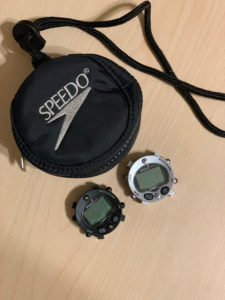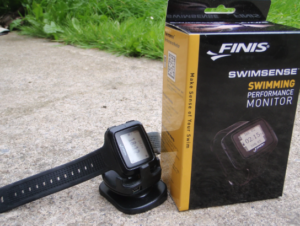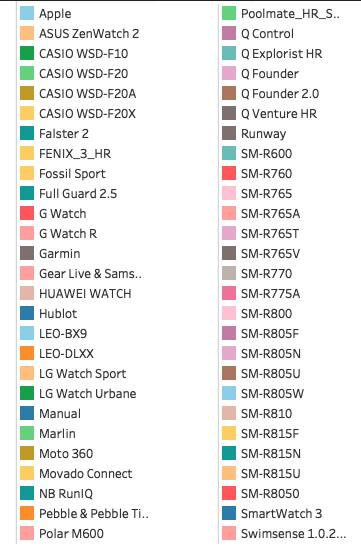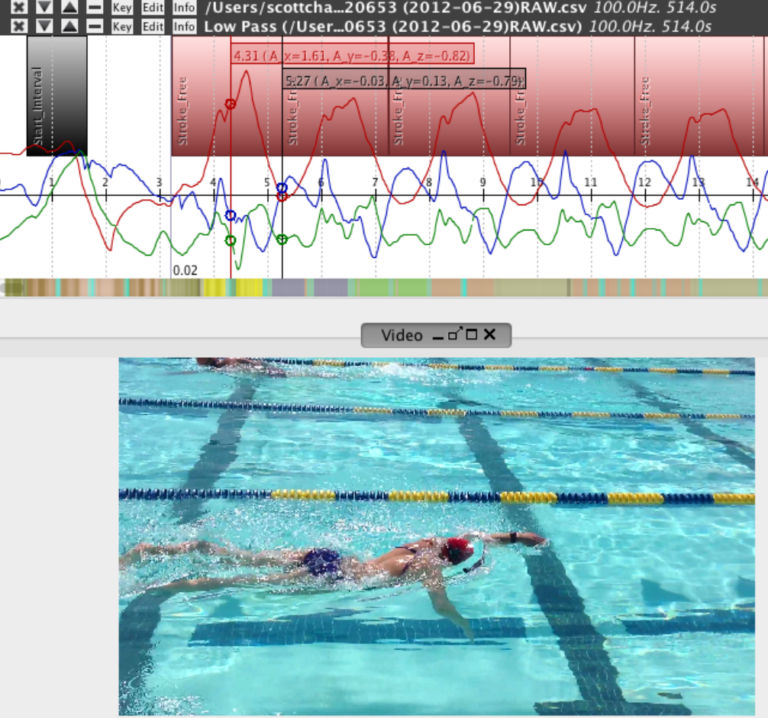Pausing to think about what we do at Swim.com and how we make use of wearable devices, we realized there is an opportunity to inform our global community of users about the basics of the tracking technology we use in and out of the pool. This will be the first of several posts we are calling “Swim Technology & Innovation”. This “stuff” can get complicated quickly so we will do our best to stick to the basics. We believe the journey through swim-tracking time itself is worth the ten minutes you’ll spend reading this post. And who knows, maybe you’ll be able to dazzle your friends with a bit of swim tech banter the next time your waiting for the Swim.com Pace mode to send you off on that next interval.
A Brief History of Swim [Tracking] Technology
Today, if someone were to mention “smart” watch, most of us would immediately think of the Apple Watch, the family of Samsung devices  or the plethora of Garmin watches. And let’s not forget about Pebble as well. However, I’d suggest looking back much further (like 1997!) and start with the launch of the Strokz Digital Swim Stroke Analysis Watch. Bill Geiser, founder of Strokz and a thought leader in the overall smart watch space,
or the plethora of Garmin watches. And let’s not forget about Pebble as well. However, I’d suggest looking back much further (like 1997!) and start with the launch of the Strokz Digital Swim Stroke Analysis Watch. Bill Geiser, founder of Strokz and a thought leader in the overall smart watch space,
partnered with Speedo to launch the first-ever automatic swim tracking watch. The Strokz was not “smart” from the perspective of being connected with your phone. It was definitely more than a time keeping device. The Strokz used a transistor switch to measure stroke count, distance per stroke, stroke rate, and several other metrics that competitive swimmers use. The Strokz watch used the transistor to understand when the arm was in the water versus out of the water thereby creating a kind of pedometer for swimmers.
About a decade later, the current President of Swim.com, was spending his lunch time at the local university pool training for the Half Ironman world championships and wondering how he could better monitor his swims. In 2009, he co-founded a start-up and partnered with Finis to build and launch the SwimSense. The SwimSense was one of the first swim tracking devices to use machine learning to automatically detect strokes, stroke type and know when you were swimming or resting without having to press a pause button. During this time, Lisa Irlam, founder of Swimovate had launched the Poolmate and was steadily going after the UK swim market and quickly expanding. While the SwimSense used a machine learning approach, the Poolmate used more of a traditional signal processing approach to identify swim metrics (at least, that’s what I recall).

While there was quite a bit of commercial product development activity during this time, there was also some great research being conducted by Dr. Daniel James from Griffith School of Engineering in Australia. Google him and his work if you have an extra 10 minutes.
By 2012/2013, the market of swim wearables was rapidly changing and Garmin was solidly in the game with the launch of swim tracking in the 910XT and the Garmin Swim Watch.
How Does Swim Tracking Work in the Pool?
Depending on the wearable (e.g. Apple Watch, Samsung, etc), there are a variety of sensors such as accelerometers, gyroscopes, magnetometers, GPS, heart rate and others that can be used to track swimming in a pool. For pool swimming, arguably the most important sensor is the accelerometer. A typical accelerometer will have three axis (X, Y, and Z) which is used to measure acceleration – the change in velocity over time. One of the core challenges any developer faces when building motion-based applications using accelerometers is understanding the impact of gravitational acceleration. Fortunately, modern-day sensors such as Apple’s Core Motion framework does the hard work for us by removing the impact of gravity (if that’s what’s desired) from the acceleration signal.
If you’ve ever wondered what motion looks like from an accelerometer when swimming freestyle, take another sip of that coffee and spend some time looking at the below chart. Here we have a device on a swimmer and we’ve synchronized the video with the sensor data (not as easy as you’d think). We then perform a number of fairly basic signal processing processes to the motion data including applying a Low-pass filter to remove unwanted high frequencies. Using the video the source as the source of truth, we then mark-up the regions of the signal that correspond to events we care about such as a freestyle stroke, turning, or resting after an interval. Below you can the red regions identify a freestyle stroke. this mark-up is then used to build and train models to recognize the parts of swimming we are interested in.
This barely scratches the surface of how motion-based swim trackers work but should give you a basic understanding of what’s happening the next time you are swimming with our Swim.com app.
The Current State of Swim Trackers
While there are dozens of different swim trackers available today (check out the chart below showing some of the devices we see on Swim.com), there are just a few platforms that currently dominate the space. And while there’s no definitive data source we can point to, at Swim.com we see the Apple Watch and Garmin as leading the pack with Samsung Gear Sport, Galaxy and Gear Fit2 Pro representing the fastest growing segment of devices in use. Perhaps Google will be making a stronger play with the release of a Pixel Watch soon? A somewhat obvious, but important aspect of these new swim tracking devices, is that they are app-driven and connected (either to your phone or Wifi or both). The connectedness of these devices means we can toss our old USB-based docking stations into the recycling bin, and enjoy a nearly seamless transition from swimming to seeing your new position on your club’s leaderboard (like this one).
Accurately capturing a swimmers metrics and doing it completely automatically, as Swim.com does, is a relatively hard technical problem to get right. However, the capabilities of the devices is growing exponentially resulting in some of that complexity being pushed down into the software and hardware layers of these platforms.

In our next post, we’ll look more closely at how Swim.com works on the Apple watch and compare it to Google’s WearOS and Samsung platforms. Until then, join our February Carry On challenge and stay on top of those swimming goals!

I truly enjoyed reading your quick overview of swim watch technology history. It’s interesting that a historical view of almost any hobby will find an avid readership.
Before I got into the world of TotalImmersion, where Terry Laughlin introduced us to the SwimSense watch, I used to use the Speedo watches which used splits and ‘intervals’, and identified fastest intervals (as I remember correctly).
Over the many years I used them, the biggest issue with Speedo was that the battery wasn’t rechargeable. In this, the gasket eventually got damaged, and one needed to buy another watch. I went through a lot of dead watches. That was one of the reasons I thought the Swimsense design was so smart; Graphs and uploading were also valuable features. I thought that the ability to correlate stroke rate along with stroke count and pace were very clever (hint, hint!). I was sorry when Mark Stephens left the company because he had great ideas as its product manager. The follow-on watch by FINIS was a horrible step backwards with little apparent learning from its first watch.
Similarly, in talking to Speedo when they suddenly stopped selling their swim watch. I was told that the driving force manager left the company and due to market size, the Company felt that any update wasn’t worth the cost and never replaced him. (So I had to do my own lap counting again for a while.) During this time, and I don’t remember how, I was in touch with Bill Geisser; I think he worked for Motorola at the time. But I got the impression he was an excellent swimmer himself. He too was frustrated with the lack of financial interest in the market; that this was a niche market. I think he felt that the ‘look’ of the watch was being overlooked as a key selling factor. I suppose that by being able to change the ‘face’ of the watch goes a long way to eliminate that issue.
I was never a great swimmer but as an engineer, the analysis of the metrics of swimming was of almost equal interest. I don’t remember how but I had the pleasure of sitting next to Bill Boomer years ago at some swimming luncheon. (Terry Laughlin claimed Bill was his mentor). Bill had ideas of writing a heavy technical paper on propulsion in swimming, But I don’t think that he ever got around to it. He used to talk about ‘body tension’ as a factor in elite swimmers. Bill was a sort-after swim consultant to some of the elite swim teams in the country. Sitting just behind him during one of the big college swim meets was great entertainment as I overheard his real-time comments about stroke technique during the competition. It was like watching Monday Night Football.
Thanks for your thoughtful efforts.
Picture 2.png
On Feb 11, 2019, at 8:09 AM, Swim.com Blog <donotreply@wordpre
Thanks for sharing all of your great insights. Glad to hear you enjoyed the article. We had a good time writing it. Every month, we will be posting another article like this one. We learn something new everyday here at Swim.com … from our development process … from the experience of our users … from the pace at which technology is moving. We aim to share, in bit size chunks, these learnings with our global community of users. Please let us know if there is a topic(s) of particular interest to you. We can add it to our list for future articles. Thank you for stopping by our blog and taking the time to share your thoughts!